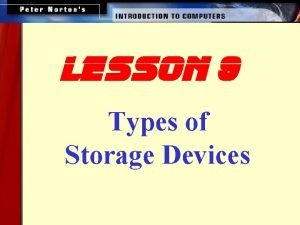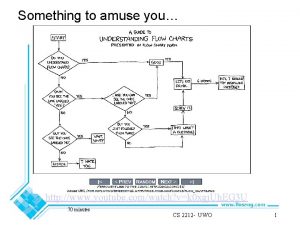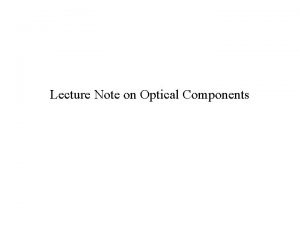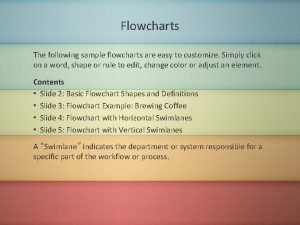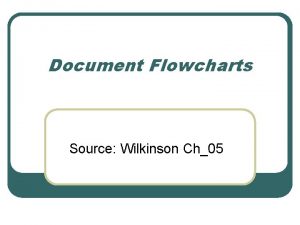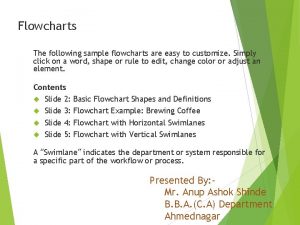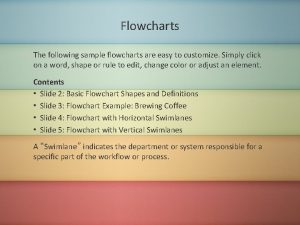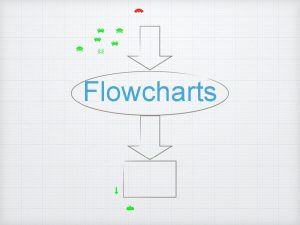Lecture 12 Optical Storage Devices Flowcharts Optical Storage












- Slides: 12

Lecture # 12 Optical Storage Devices Flowcharts

Optical Storage Devices It is a storage medium that can be written to and read using a laser beam.

Two Kinds of Optical Storage Devices Ø CD-ROM (compact disk read-only memory) Ø DVD-ROM (digital video disk read-only memory)

Optical Storage Devices – How Optical Storage Works Ø An optical drive uses reflected light to read data. Ø To store data, the disk's metal surface is covered with tiny dents (pits) and flat spots (lands), which cause light to be reflected differently. Ø When an optical drive shines light into a pit, the light cannot be reflected back. This represents a bit value of 0 (off). A land reflects light back to its source, representing a bit value of 1 (on).

1 0

Optical Storage Devices – CD-ROM Ø In PCs, the most commonly used optical storage technology is called Compact Disk Read-Only Memory (CD-ROM). Ø A standard CD-ROM disk can store up to 700 MB of data. Ø Once data is written to a standard CD-ROM disk, the data cannot be altered or overwritten.

Optical Storage Devices – CD-ROM Speeds and Uses Ø Early CD-ROM drives were called single speed, and read data at a rate of 150 KBps. Ø CD-ROM drives now can transfer data at speeds of up to 7800 KBps. Data transfer speeds are getting faster. Ø CD-ROM is typically used to store software programs. CDs can store audio and video data, as well as text and program instructions.

Optical Storage Devices Other Optical Storage Devices Ø A CD-Recordable (CD-R) drive lets you record your own CDs, but data cannot be overwritten once it is recorded to the disk. Ø A CD-Rewritable (CD-RW) drive lets you record a CD, then write new data over the already recorded data. (100 times overwriting is possible) Ø Photo. CD technology is used to store digital photographs.

Digital Video Disk (DVD) Ø A variation of CD-ROM is called Digital Video Disk Read-Only Memory (DVD-ROM), and is being used in place of CD-ROM in many newer PCs. Ø Storage capacity ranges from 9. 4 GB to 17 GB

Optical Storage Devices - DVDROM Ø Standard DVD disks store up to 9. 4 GB of data— enough to store an entire movie. Ø Dual-layer DVD disks can store up to 17 GB. Ø Dual-layer DVD disks can store so much data because both sides of the disk are used. Ø Device’s laser beam can read data from the first layer and then look through it to read from the second layer.

Recordable Optical Technologies Ø DVD-Recordable (DVD-R) Record data onto a special recordable digital video disk using a special drive. Ø DVD-RAM Record, erase, re-record data.

Flowcharts
 Book
Book What are optical storage devices are most commonly known as
What are optical storage devices are most commonly known as Flowchart symblos
Flowchart symblos Xkcd flowcharts
Xkcd flowcharts Algorithms and flowcharts
Algorithms and flowcharts Pseudocode tools
Pseudocode tools Program design flowchart
Program design flowchart Example pseudocode
Example pseudocode 01:640:244 lecture notes - lecture 15: plat, idah, farad
01:640:244 lecture notes - lecture 15: plat, idah, farad Optical amplifiers lecture notes
Optical amplifiers lecture notes Power semiconductor devices lecture notes
Power semiconductor devices lecture notes Optical devices
Optical devices Optical scanner devices are
Optical scanner devices are

